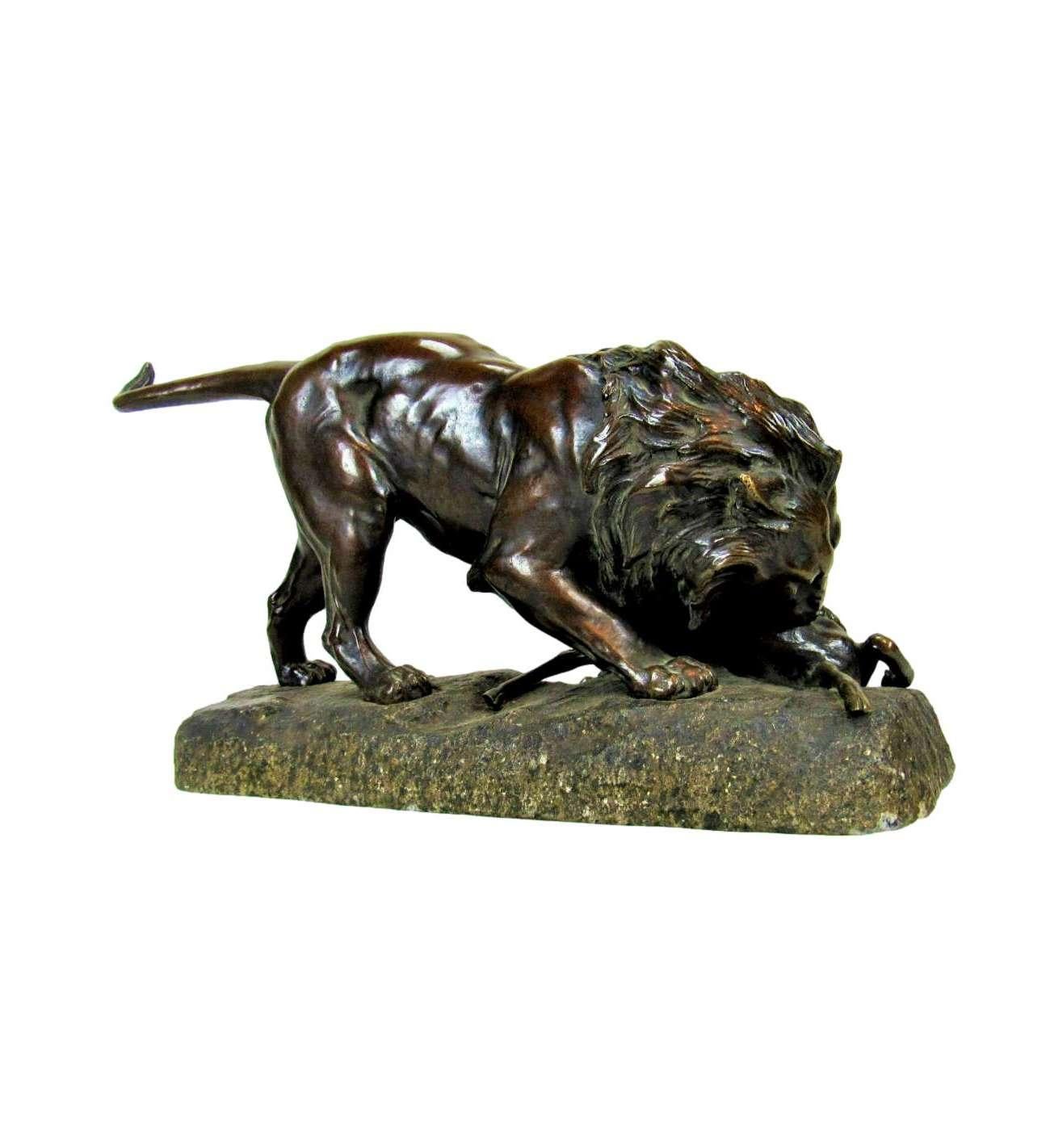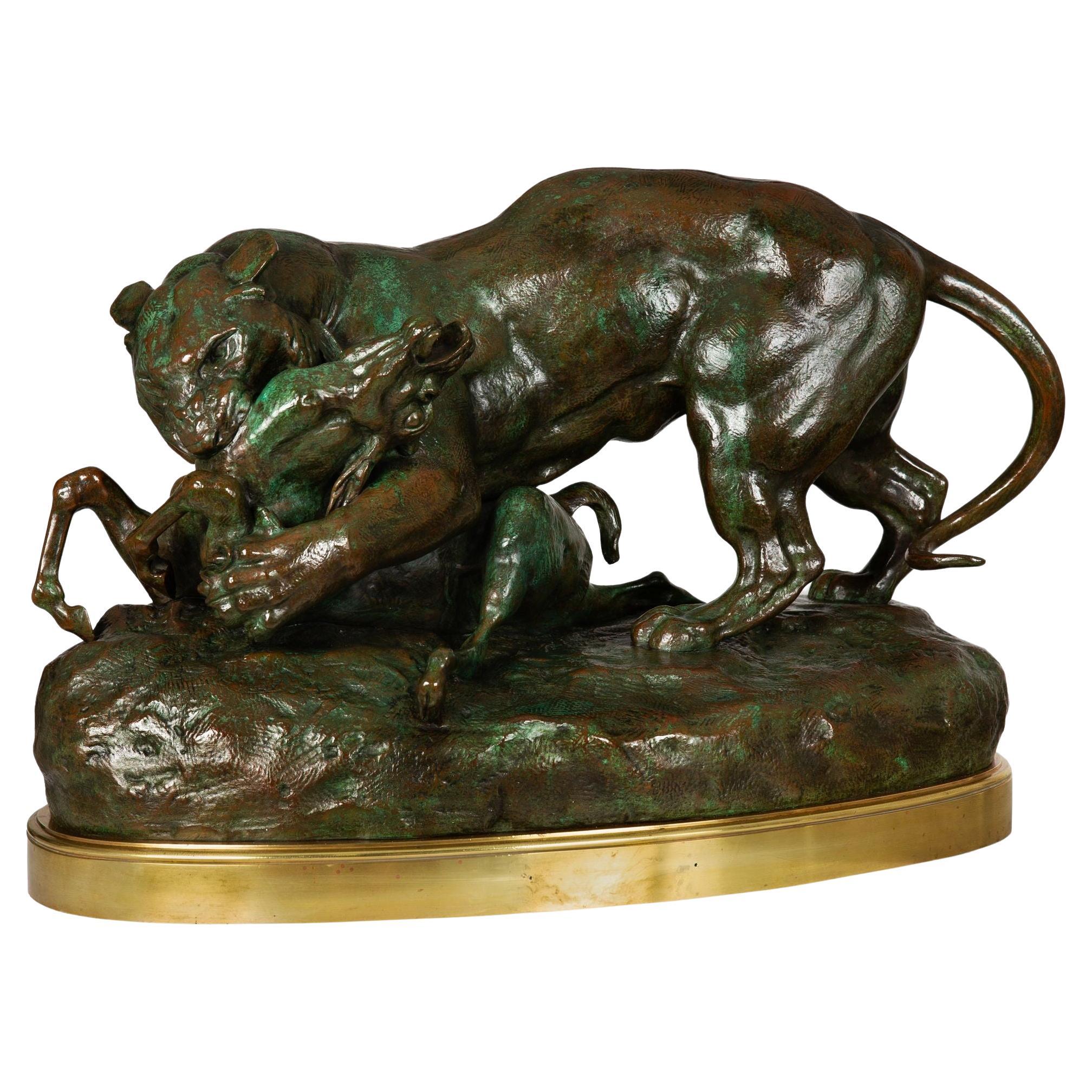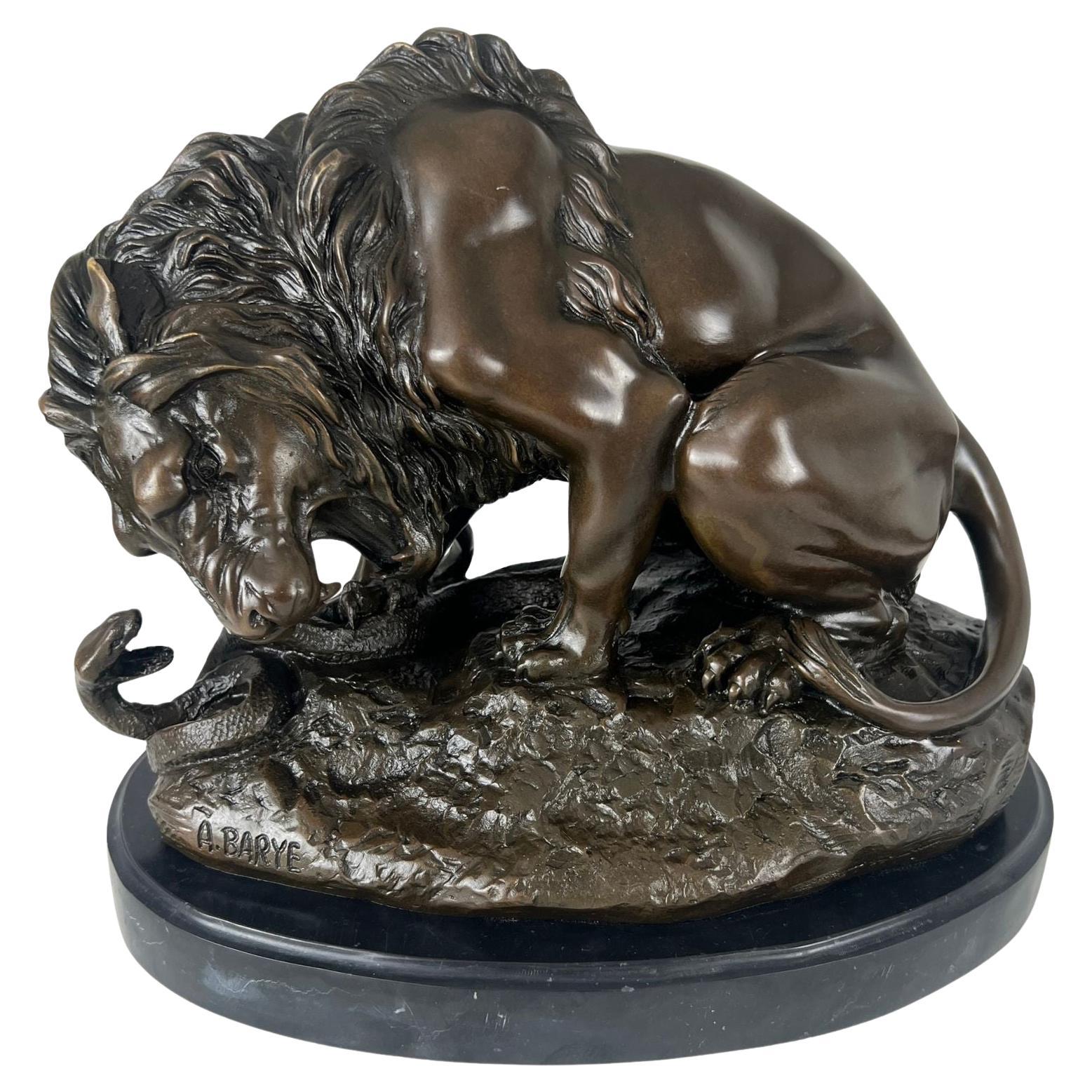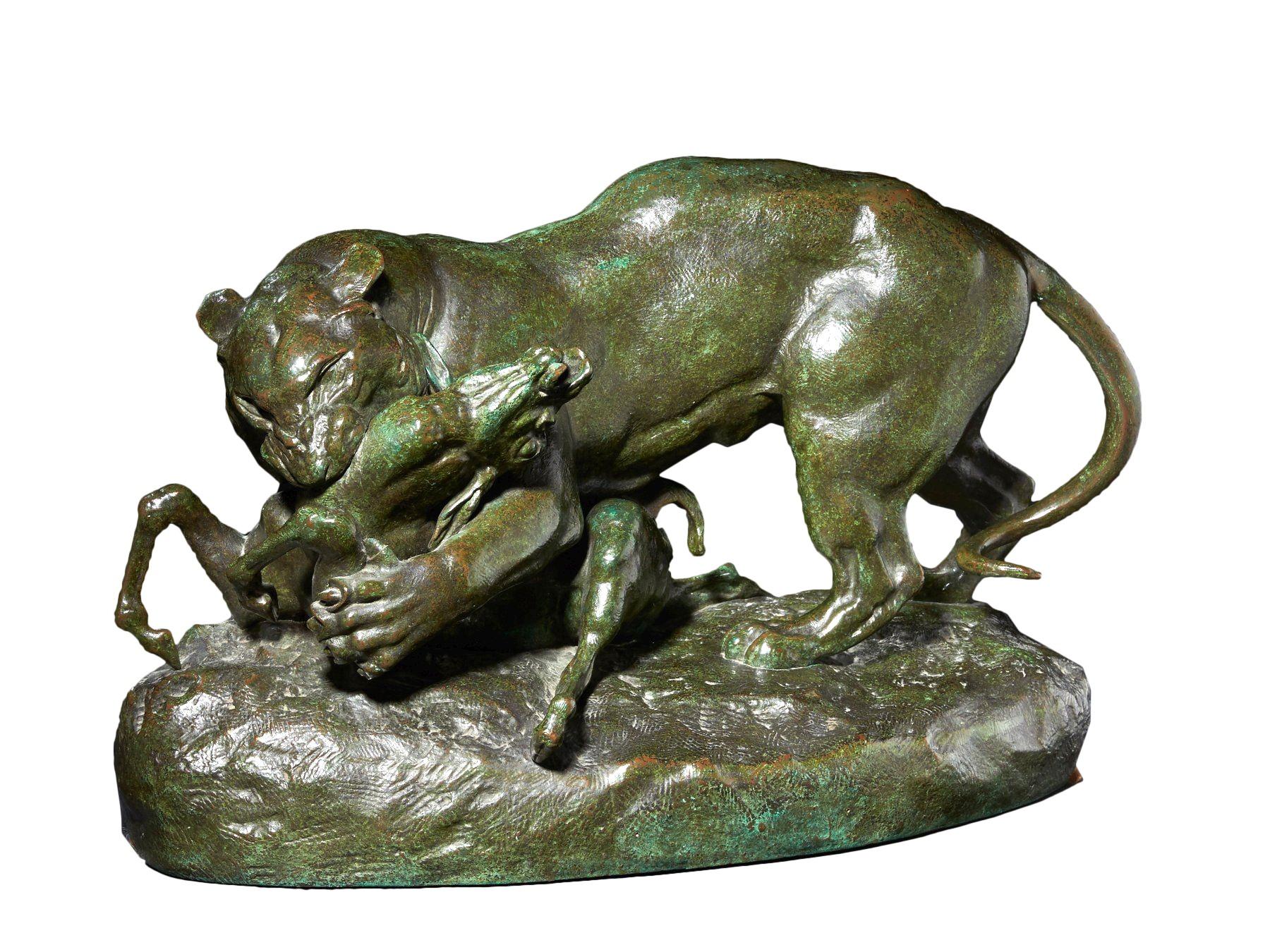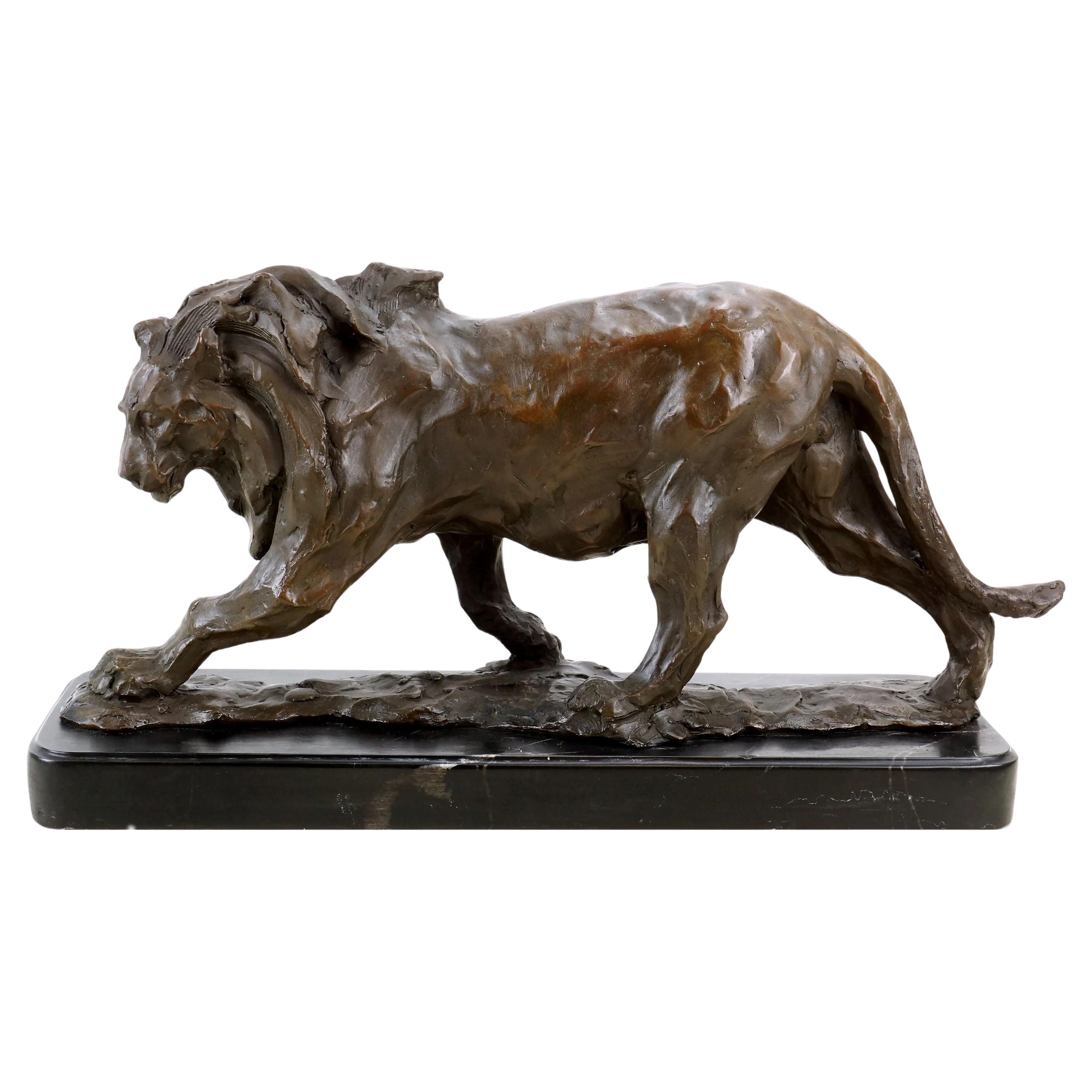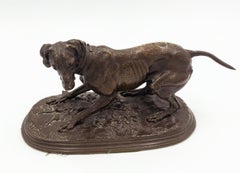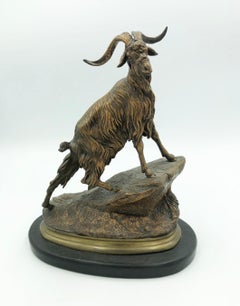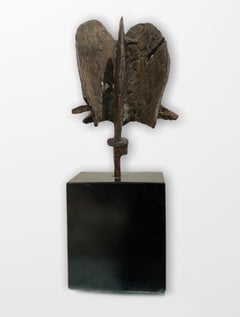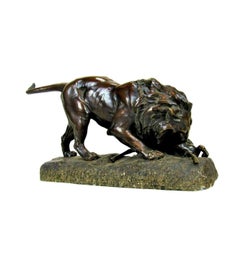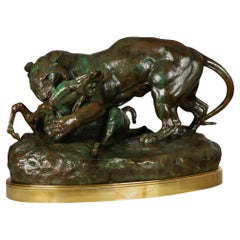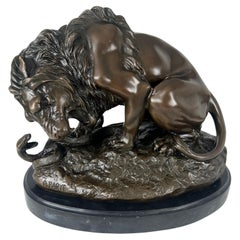Items Similar to Lion and Antelope (No. 23)
Want more images or videos?
Request additional images or videos from the seller
1 of 5
Alfred BaryeLion and Antelope (No. 23)
Price Upon Request
Price Upon Request
Price Upon Request
Price Upon Request
Price Upon Request
Price Upon Request
Price Upon Request
Price Upon Request
Price Upon Request
Price Upon Request
About the Item
Alfred Barye (1839-1882)
"Lion and Antelope"
Bronze
Approx. 7.5H x 9W x 4D inches
Signed "BARYE.ALF" and Inscribed under base "NO. 23 LION AND ANTELOPE"
The son of a goldsmith, Parisian born Antoine-Louis Bayre was a sculptor of animal subjects and acclaimed, not only for his apparent skill, but as the founder of what became known as the French Animaliers School. Among his patrons were representatives of the state government and royalty including the Duke of Orleans and the Dukes of Luynes, Montpensier and Nemours.
Well compensated financially, he was able to buy the best of materials and hire the country's most skilled foundry craftsmen. The foundry he hired was owned by Ferdinand Barbedienne, and casts from this period were stamped with the letters, FB. However, he did not make a lot of money from his work because he was such a perfectionist that often he would not sell his work because he thought it was not 'quite right'. In 1848, he declared bankruptcy, and his molds and plaster casts were sold along with the copyrights.
Bayre's specialty was aroused, angry seeming wild game such as lions and tigers and elephants, but he also did equestrian groups and mythology figures. In order to do realistic depictions of animal anatomy, he spent much time at the Jardin de Plantes in Paris.
His early training was as an apprentice to a metal engraver, but being drafted in the army in 1812, ended that education. In 1832, he had established his own studio, and unique at that time was his method of cold stamping his bronze casts, so that each one had a special number. He had his first entry, The Milo of Croton, in the Paris Salon in 1819, winning a second prize. In 1831, a work regarded as a masterpiece, Tiger Devouring a Gavial, was in the Salon, and purchased for the Luxembourg Gardens, is now in the Louvre. However, many of his subsequent Salon submissions were rejected and so angered him that between 1836 and 1851, he refused to submit entries. In 1851, he again exhibited at the Salon with Jaguar Devouring A Hare, and this work, like the 1831 entry, was placed in the Luxembourg Gardens and eventually in the Louvre.
In spite of problems with the Salon, Bayre received many accolades for his work, and the period of 1837 to 1848 was considered the most productive time of his career. However, in 1848, when he lost control of his work and it was reproduced by others including Martin and Barbedienne, the sculptures, according to some art professionals, are not as skillfully executed---in other words, devoid of the perfection he strove so hard to achieve.
In 1848, after his bankruptcy, Barye became Director of Casts and Models in the Louvre, until 1850, when he was replaced by Emmanuel Fremiet. It was a very difficult time for him. However, within a few years, he began receiving accolades for the quality and uniqueness of his work, and people began appreciating the powerful images of his sculpture---especially the wildlife in their natural surroundings.
In 1854, he was appointed Master of Zoological Drawing in the Musee d'Histore Naturelle, and held this position until his death in 1875. There one of his pupils was Auguste Rodin, who would become a revolutionary modernist sculptor of figure and portrait subjects. By 1857, Bayre was recovered financially and resumed controlled of his casts and models. Although he continued with his former subject matter, the many state commissions he received took most of his creative energy.
He also received many official honors such as Officer in the Legion d'Honneur, first presidency of the Central Union of Beaux Arts, Grand Medal at the Exposition Universelle in Paris, and membership in the Institute of France.
His work as a sculptor ended in 1869 when he was 73, and after his death, six years later, Ferdinand Barbedienne purchased most of his plasters and molds. Barbedienne, who was Bayre's original foundry owner and who had accommodated the perfection demanded by the sculptor, continued casting bronzes. These posthumous works reportedly have the same meticulous attention to detailing that Bayre would have demanded.
- Creator:Alfred Barye (1839 - 1882)
- Dimensions:Height: 7.5 in (19.05 cm)Width: 9 in (22.86 cm)Depth: 4 in (10.16 cm)
- Medium:
- Movement & Style:
- Period:
- Condition:
- Gallery Location:Missouri, MO
- Reference Number:1stDibs: LU74735205871
About the Seller
5.0
Vetted Professional Seller
Every seller passes strict standards for authenticity and reliability
Established in 1970
1stDibs seller since 2017
156 sales on 1stDibs
Typical response time: Several days
- ShippingRetrieving quote...Shipping from: Missouri, MO
- Return Policy
More From This Seller
View AllThe Hunter and Hound
By Pierre Jules Mêne
Located in Missouri, MO
Pierre-Jules Mene
"The Hunter and Hound" (Le Valet de Limier) 1879
Bronze
approx. 19 x 8 x 14 inches
Signed
PIERRE JULES MENE (1810-1879)
Pierre...
Category
1870s Realist Figurative Sculptures
Materials
Bronze
Price Upon Request
Chien Braque (Tom)
By Pierre Jules Mêne
Located in Missouri, MO
Pierre Jules Mene
"Chien Braque" (Tom)
Bronze
approx. 5 x 9 x 4.25
Signed
PIERRE JULES MENE (1810-1879)
Pierre Jules Mene, (P. J. Mene), was born in Pa...
Category
1860s Realist Figurative Sculptures
Materials
Bronze
Mountain Goat
By Jules Moigniez
Located in Missouri, MO
Jules Moigniez
"Mountain Goat"
Bronze
approx 11 x 9 x 4 inches
Signed
Jules Moigniez (1835-1894)
Jules Moigniez was born in Senlis sur L'Oise, France ...
Category
1870s Realist Figurative Sculptures
Materials
Bronze
Piccolo Guerriero (Little Warrior)
By Luciano Minguzzi
Located in Missouri, MO
Luciano Minguzzi (Italian, 1911-2004)
Piccolo Guerriero (Little Warrior) c. 1950s
Bronze
Monogrammed and Numbered 1/5
Height From Base to Top: approx. 12" High
Bronze: 6 3/4 inches x 4W x 3D
Luciano Minguzzi was born in Bologna in 1911 and died in Milan in 2004. In 1943 he took part in the Fourth Quadrennial of Rome. In 1950 he was awarded the grand prize for sculpture at the XXV Venice Biennale, and attended again in 1952.
His works can be found at Museum of the Fabbrica del Duomo, in the Museum of Modern Art in the Vatican and in the Galleries of Modern Art in Rome, Milan, Bologna, Florence, Trieste, Verona, Carrara, Padova, as well as abroad and overseas.
Additional Biography (translated from Italian):
Luciano Minguzzi ( Bologna , 24 May 1911 - Milan , 30 May 2004 ) was a sculptor and medalist Italian .
Image of the exhibition Luciano Minguzzi: sculptures and gouaches 1950-1970 in the Romanesque cloister of the Cathedral of Prato ( Museo dell'Opera del Duomo ), 24 April - 24 May 1971. Photo by Paolo Monti .
Index:
He made his first experiences under the wise guidance of his father, also a sculptor , continuing his studies at the Academy of Fine Arts in Bologna following the engraving courses held by Giorgio Morandi , those of sculpture under the guidance of Ercole Drei , attending at ' university the lessons Roberto Longhi.
Thanks to a scholarship, he stayed in Paris and London , starting to exhibit in 1933 and already at the Roman Quadrennial of 1943 he obtained his first prize, which was followed by others including the Angelicum of 1946 and the first place ex aequo at the Biennale del 1950.
Immediately after the war he created the monument to the Partisan and the Partisan for his hometown , located near Porta Lame , in the area where an epic battle between Nazi-Fascists and partisans took place in 1944 .
The work, composed of two figures of young people - one of which armed - caught in a moment of great naturalness, was forged with cast bronze from the equestrian statue of Benito Mussolini (by Giuseppe Graziosi ) which was located inside the current "Renato Dall'Ara" Stadium, in turn made with some cannons stolen from the Austrians during the Bolognese Risorgimento uprisings of 1848.
Still on the theme linked to war , but with a changed style with more dramatic and expressionist tones , in the fifties he created a series of sculptures inspired by the theme of the men of the Lager and the unknown and anonymous victims, obtaining in 1953 the third prize in the competition for the "Monument to the Unknown Political Prisoner " announced by the Tate Gallery ( London ).
In 1950 he won the competition for the "Quinta Porta" of the Milan Cathedral , completed in 1965 .
In 1962 he participated, together with the most important international sculptors of the time, in the exhibition Sculptures in the city organized by Giovanni Carandente as part of the V Festival dei Due Mondi in Spoleto . He presented a 1958 iron and bronze sculpture entitled Pas-de-quatre.
In 1970 he was given the task of building the "Door of good and evil" of the basilica of St. Peter in the Vatican , on which he worked with vigor and passion for seven years.
In 2012, on the occasion of the centenary of the artist's birth, a posthumous anthological exhibition was set up in Bologna at the Fondazione del Monte [1] .
He also worked as a medalist: his example is the silver 500 lire coin...
Category
Mid-20th Century Modern Abstract Sculptures
Materials
Bronze
Price Upon Request
La Cothurne
By Agathon Léonard
Located in Missouri, MO
"La Cothurne" 1901
Gilt Bronze
Approx 21.5" High (to raised hand)
Signed and Dated
Foundry Mark "Susse Freres"
Originally modeled in white biscuit porcelain this Greek dancer is a from a set of eight created for a dining table. They were immediately successful when they were exhibited in the Sevres pavilion at the 1900 Exhibition. Individual figures could be ordered and "La Cothurne" proved the most popular. Their success led to the firm of Susse buying the right to cast versions in metal.
Agathon Leonard (1841-1923) is one of the well-known French Art Nouveau sculptors. Born in Lille in 1841, he first studied there before moving to Paris where he studied at the Ecole des Beaux Arts under Eugene Delaplanche.
He gained recognition at the annual Expositiones Universelles, winning a Silver Medal there in 1889 and gold in 1900. His most important piece, Jeu L'echarpe, was the best known series of Sevres production at the turn of the century and sold out at the 1900 Expo in Paris and later was given as a gift by the French Gov't to Nicholas II at the Hermitage.
His bronzes were cast at the Susse Freres Editeurs Foundry. He worked also in marble, quartz and ivory. He also produced Art Nouveau medallions...
Category
Early 1900s Art Nouveau Figurative Sculptures
Materials
Bronze
Price Upon Request
Preparing to Ride
Located in Missouri, MO
Preparing to Ride
By. George B. Marks (American, 1923-1983)
Signed and Dated
Throughout his artistic career, George Marks’s work was always guided by the...
Category
1970s American Realist Figurative Sculptures
Materials
Bronze
Price Upon Request
You May Also Like
Georges Gardet — (1863-1939)+ Bronze cast, Lion Devouring an Antelope
By Georges Gardet
Located in Gent, VOV
Lion Devouring an Antelope
A fine bronze cast of a lion, representing the carnivore who has just killed an antelope, by Georges Gardet (1863-1939). An old cast with a dark brown sha...
Category
Late 19th Century Realist Figurative Sculptures
Materials
Bronze
Lion and snake
By Antoine-Louis Barye
Located in PARIS, FR
Lion and snake n°3
by Antoine-Louis Barye (1796-1875)
Bronze sculpture with a nuanced dark greenish brown patina
signed "Barye" on the base
old edition cast – probably from the Bary...
Category
1860s French School Figurative Sculptures
Materials
Bronze
Bronze Sculpture “Tiger Surprising an Antelope” by Antoine-Louis Barye
By Antoine-Louis Barye
Located in Shippensburg, PA
ANTOINE-LOUIS BARYE
French, 1796-1875
"Tigre Surprenant une Antilope (terrasse sans profil)" (1862)
Green, brown and red patinated sand-cast bronze over original raised rim signed...
Category
Antique 19th Century French Romantic Animal Sculptures
Materials
Bronze
Bronze Sculpture, Lion with Snake, After A. Barye, France, 20th Century.
By Antoine-Louis Barye, Warranty Paris JB Depose
Located in Regensburg, DE
Solid bronze figure of a lion fighting a snake, a famous motif by A. BARYE.
Engraved on the plinth “A. BARYE” (Antoine-Louis Barye, 1795–1875), one of the most important French sculp...
Category
Vintage 1970s French Neoclassical Animal Sculptures
Materials
Marble, Bronze
$2,082 Sale Price
20% Off
Antoine - Louis BARYE (1795-1875)Tiger surprising an antelope Bronze
By Antoine-Louis Barye
Located in Gent, VOV
Tiger surprising an antelope (terrace without profile)
Bronze with a shaded green patina, circa 1880
Signed 'BARYE', stamped 'H' by the founder Brame
Antoine-Louis Barye (1796-187...
Category
19th Century Figurative Sculptures
Materials
Bronze
Lion Statue, Walking Lion, in the style of Rembrandt Bugatti Bronze Sculpture
By Rembrandt Bugatti
Located in Saint-Ouen, FR
This lion statue is a bronze sculpture in the style of Rembrandt Bugatti. The statue depicts a walking lion mid-stride, capturing dynamic energy and majestic motion with precise anat...
Category
20th Century French Modern Animal Sculptures
Materials
Bronze
More Ways To Browse
Antique Lion
Antique Lion Sculpture
Sculptures Of Lions
Bronze Lion Sculpture
Antique Plaster Cast
Lion Sculpture Bronze Gold
19th Century French Bronze Sculpture Lion
Barye Bronze
Barye Bronze Sculptures
Lion And Tiger
Antelope Sculpture
Fremiet Emmanuel
Elephant And Tiger
Antique Jaguar
Bronze Antelope
Barye Lion
Antoine Louis Barye Lion Plaster
Barye Lion Sculpture
